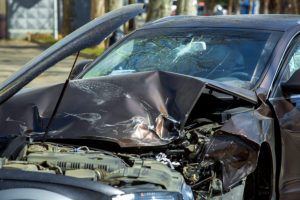 Three occupants of a pickup truck were injured in a head-on collision with a semi-truck on Route 903 in Lake Harmony. One of those occupants sustained life-threatening injuries and was transported via helicopter to the hospital, while the other two were taken by ambulance. At the time of the report, police had not yet determined the cause of the crash. The semi-truck driver was uninjured.
Three occupants of a pickup truck were injured in a head-on collision with a semi-truck on Route 903 in Lake Harmony. One of those occupants sustained life-threatening injuries and was transported via helicopter to the hospital, while the other two were taken by ambulance. At the time of the report, police had not yet determined the cause of the crash. The semi-truck driver was uninjured.
Head-on collisions and collisions involving semi-trucks are among the most deadly of all traffic collisions. Pennsylvania saw more than 4,700 head-on collisions in 2017, resulting in 122 fatalities. In the same year, there were more than 6,000 crashes involving heavy trucks, with 145 of them fatal and 2,860 producing injuries.
The Dangers of Head-On Collisions
A head-on collision—also known as a frontal collision—occurs when two vehicles, traveling in opposite directions, collide. The point of impact for both vehicles is the front. This type of accident, though making up a relatively small number of traffic crashes that occur in the U.S. each year (about 2 percent), is over-represented in fatalities, accounting for around 10 percent. The reason for this is that, as both cars are moving at the time of the crash, the force of the collision is multiplied, and the risk of becoming injured is increased due to the sudden loss of speed. Those who survive this type of accident are often left with severe and debilitating injuries, including:
- Traumatic brain injuries, which can lead to severe deficits in all levels of function.
- Spinal cord injuries, which can result in paralysis in the legs and pelvis (known as paraplegia), or in the legs, pelvis, shoulders, arms, hands, and torso (known as quadriplegia or tetraplegia).
- Severe lacerations, which can cause permanent scarring and the need for skin graft surgeries.
- Burns from the airbag deployment, gasoline, and other chemicals from the vehicles, or a fire inside the vehicle.
- Limb amputations, which may be caused during the accident or medically performed in the course of treating trauma due to the accident.
- Broken bones, which may require surgery to set and may result in limited use of the limb involved.
- Severe internal trauma, including punctured lungs or damaged organs as the result of broken ribs, penetration into the abdomen by sharp objects during the course of the accident, or blunt force or crush trauma.
- Post-traumatic stress disorder, or PTSD, is a debilitating condition. Traffic collisions are the leading cause of PTSD in the country.
The Dangers of Commercial Truck Accidents
There are around 450,000 accidents involving commercial trucks in the U.S. every year, resulting in the deaths of around 5,000 people. 74 percent of the fatalities in accidents involving tractor-trailers are the occupants of passenger cars. Commercial trucks pose unique risks to others on the roadway, mostly due to their size. Some of those risks include:
- More time and space required to come to a safe stop. The distance necessary to stop a large truck becomes even greater if there is inclement weather or if the driver is speeding.
- Wide turns: Tractor-trailers are up to 14 feet tall and feature a high center of gravity that makes them vulnerable to loss of control if maneuvering or turning too fast. These trucks also feature a 55-foot turn radius, which sometimes requires them to encroach on other traffic lanes to complete the turn. This poses a risk to other vehicles who may be traveling in the lanes that the truck has encroached.
- Weight: Commercial trucks, when fully loaded, can weigh up to 80,000 pounds. This is 20 to 30 times more weight than the average-size passenger car, which makes for particularly dangerous situations for the occupants of passenger cars.
What Causes Head-On Collisions With Trucks?
The Federal Motor Carrier Safety Administration reports that there are about 4,000 fatal head-on collisions involving large trucks each year in the United States. Yet, this type of accident only accounts for about 3 percent of all accidents involving large trucks. What causes a head-on truck accident? Here are some of the reasons:
- Distracted driving: Truck drivers have a lot of time alone while they’re on duty. This may cause them to entertain themselves with distractions, such as talking on the phone, texting, browsing the internet, eating or drinking, fiddling with the vehicle controls or the GPS, or looking at billboards or other external distractions. Distracted driving causes drivers to miss important information needed to operate their vehicles safely, including the ability to notice signs indicating that a road is one-way, wrong-way drivers, or other roadside hazards that may lead to an accident. Cell phone use for texting or talking became such a concern that the FMCSA prohibits all texting by commercial truck drivers and limits phone usage to hands-free devices that don’t involve pressing more than one button to dial.
- Unfamiliarity with the roadway: Truck drivers are often required to transport goods into, out of, and through cities that they are unfamiliar with. Unfamiliarity with the roadway is a leading cause of wrong-way accidents, which are one of the more common types of head-on collisions.
- Previous accidents: Due to the size of tractor-trailers, they are difficult to maneuver and require more distance to come to a complete stop. Debris on the road from previous accidents may cause a driver to swerve or lose control, increasing the risk of encroaching on the oncoming traffic lane and having a head-on collision. Additionally, sometimes the truck or car involved in the head-on collision is involved in another accident immediately before in which the force of the collision pushed the vehicle into oncoming traffic.
- Inclement weather: Although weather causes few head-on truck collisions, icy road surfaces or low visibility are both potential factors that could cause a driver to lose control and wind up traveling in the wrong lane of traffic.
- Fatigued driving: The dangers of truck drivers falling asleep behind the wheel are so real that the federal government regulates the number of hours that drivers can drive before taking an off-duty break. Unfortunately, some drivers bend the rules to get their shipments delivered on time, meaning that the risk of drowsy truck drivers on the road remains. Additionally, the FMCSA notes that nearly a third of all truck drivers are believed to suffer from sleep apnea, which is a breathing-related disorder that causes multiple interruptions during sleep and leaves an individual feeling drowsy, even if he or she has had a full night’s rest.
- Alcohol impairment: Alcohol impairment diminishes a driver’s ability to operate his or her vehicle safely, impacting functions such as focus, judgment, the ability to control a vehicle, and the ability to multi-task. As large trucks already pose risks due to maneuverability and control problems, an alcohol-impaired truck driver is a particularly deadly actor on the roadway. Alcohol impairment by the driver of a passenger car also increases the chance of having a serious accident, such as a head-on truck collision.
- Medical issues: Truck drivers are required to undergo physical examinations to ensure that they are healthy enough to perform the job of transporting goods, often across many miles and many state lines. Unfortunately, these examinations don’t always catch all medical issues that a driver may be dealing with. Many accidents have been the result of truck drivers who lose consciousness due to a heart attack, stroke, or other medical problem and are rendered unable to operate their vehicles safely.
- Passing on a solid yellow: Narrow, two-lane roads allow for one vehicle to pass another as long as there is a broken yellow line indicating that the conditions are safe for the following driver to safely enter the oncoming traffic lane to pass the lead vehicle. Many people opt to take a risk and pass on the solid yellow line, which indicates that there is a turn or reason why the visibility of oncoming traffic is limited, and it is, therefore, unsafe to pass. Passing other vehicles on curves is a major cause of accidents in rural areas where roadways tend to be narrower and more winding.
- Swinging wide around a blind turn: Trucks require more space to turn, making those in other lanes of traffic vulnerable to getting caught in a truck’s path.
How Can I Avoid Having a Head-On Collision With a Truck?

It is impossible to eliminate all risk when driving. However, these tips can help to reduce your chance of having a head-on collision with a commercial truck:
- Stay visible. Remember that trucks have large blind spots on all four sides that prevent truck drivers from seeing smaller vehicles that are driving directly in front of, behind, or to either side of them. While blind spots generally aren’t the culprit for head-on collisions, they are the cause of a lot of accidents that could result in encroachment into the oncoming lane of traffic, which could lead to a head-on collision.
- Avoid distractions that draw your focus from the roadway and detection of potential hazards. As one of the most common causes of head-on collisions is wrong-way drivers, know how to properly respond if you spot a wrong-way driver traveling in your direction. You should flash your lights and honk in an attempt to get the driver’s attention. Steer as far to the right of the driver as you can. Although the best-case scenario is that your tires do not leave the pavement, if the driver does not stop, you should leave the roadway to avoid this type of collision.
- Pay attention to road signs when traveling in an area that is unfamiliar to you to avoid becoming a wrong-way driver yourself.
- Be sure you are alert, well-rested, and sober when getting behind the wheel. If you are dealing with anger, stress, or other emotions, it is wise to wait until you’ve calmed down before driving. In short, if there is something on your mind that is more important to you at that moment than driving, wait to go until you can make driving a priority.
- Hitting a stationary object, particularly if you have slowed down or can strike it at an angle, is generally safer than getting into a head-on collision with a semi-truck. While no one wants to have to make this choice, if you must, then it is better to hit something that is not moving.
- While it won’t help you avoid a head-on collision, wearing a seat belt will decrease the risk of suffering severe injuries in a head-on or any other type of accident. Most accidents happen when an individual is within ten miles of home, so seat belts are just as important when you’re going to the grocery store down the street as they are during long road trips.
What Should I Do If I Was Injured or I Lost a Loved One to a Head-On Truck Accident?

If you are injured, the most important thing to do is focus on your recovery. If you have lost a loved one, allow yourself the opportunity to grieve. Beyond that, however, you are likely faced with expenses due to your injury or your loved one’s death. An experienced truck accident attorney can answer your questions as to how to pursue compensation to cover your expenses, both current and future. Your attorney can also help you identify liable parties in your accident and sources of insurance coverage that are available to pay for your damages.
Initially, you and your attorney will likely seek compensation via a third-party insurance claim against the at-fault individual or entity’s policy. The amount of compensation you seek depends on the individual facts of your case, the expenses you face, and the impact that the accident has had, and will have, on your personal and professional life. If a settlement is not forthcoming, you may choose to file a personal injury lawsuit or a wrongful death claim against the at-fault parties.
For more information about this process, schedule a free consultation with an experienced truck accident attorney.